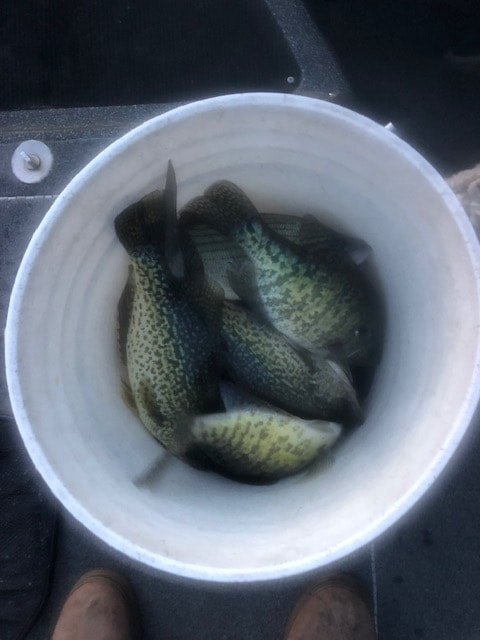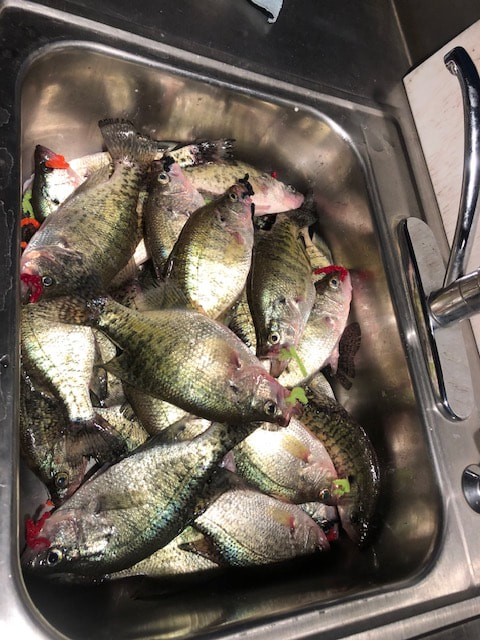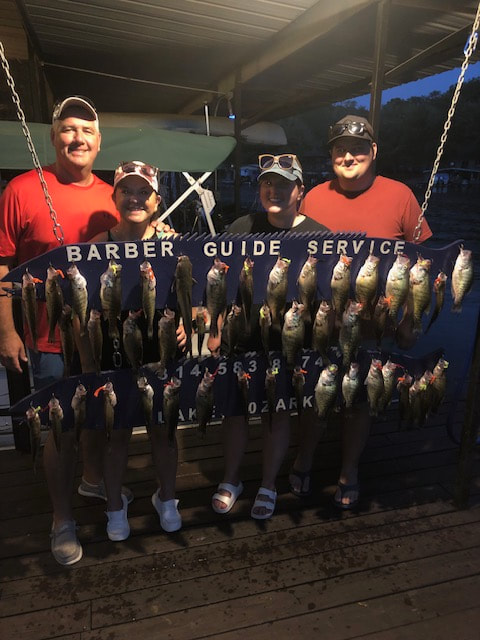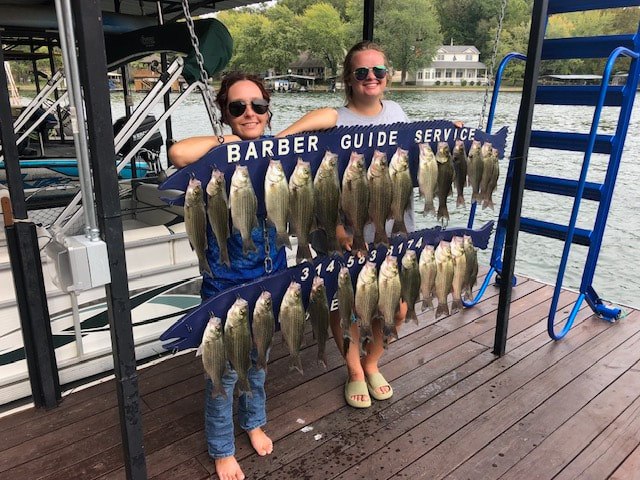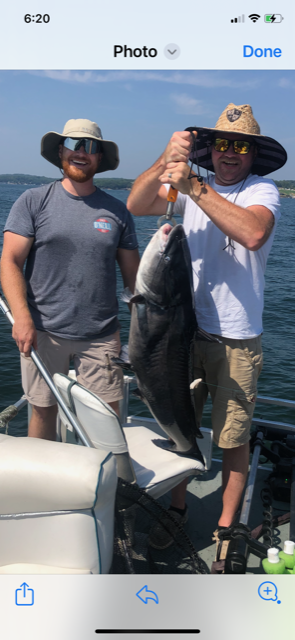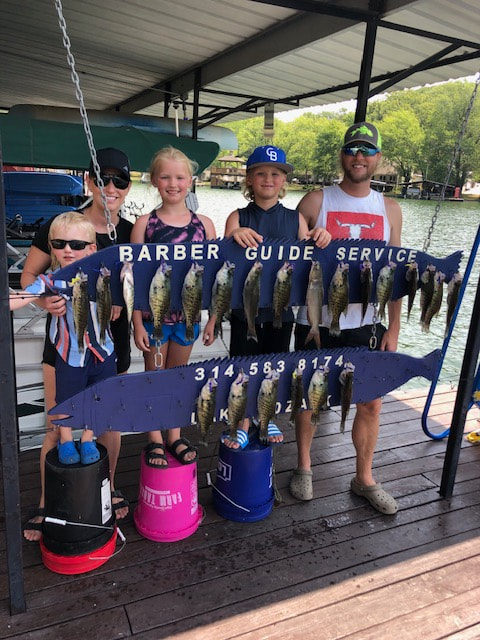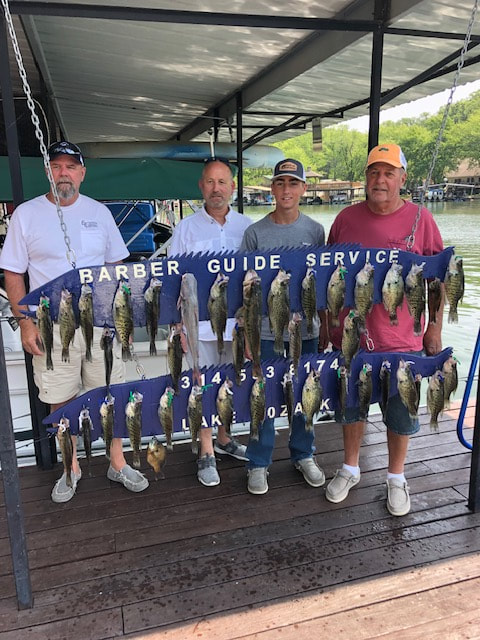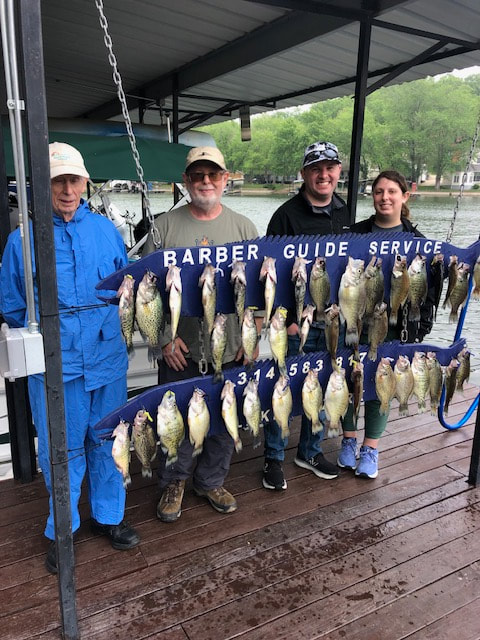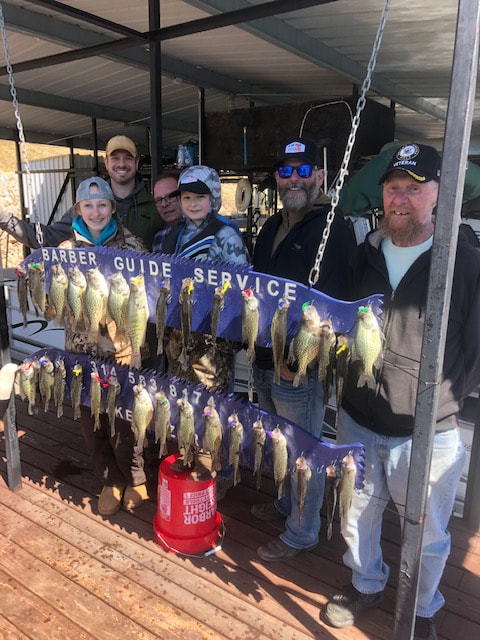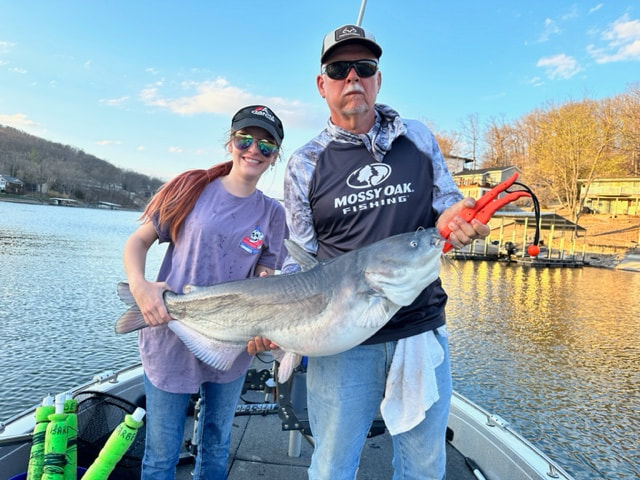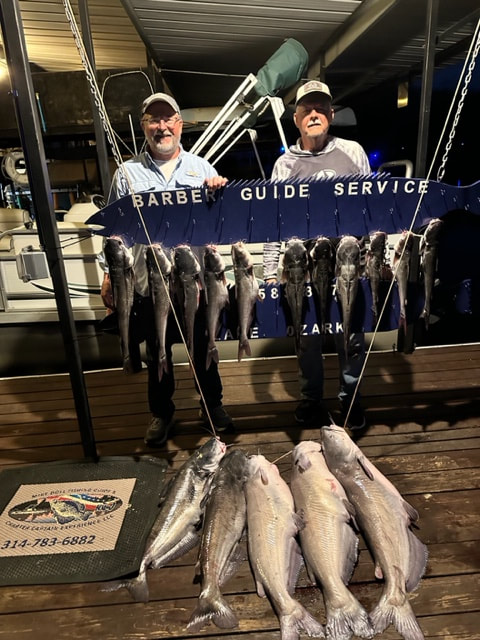|
The Crappie Spawn is winding down on Lake of the Ozarks. Most Crappie and Bass spawned deeper this year due to water clarity and that disappointed a lot of anglers who didn't capitalize on the deeper bite. Now that the Crappie spawn is slowing down a lot of Crappie and Bass are scattered chasing shad to gorge and regain strength and body weight. During this time we catch a lot of Crappie and Bass trolling Crank Baits. Find a cove with a significant volume of shad and begin trolling. (Side Scan Imaging) Right now a lot of the bait fish are located in the middle to back part of coves (15-40 feet of water) and are 10-20 feet deep. We use Bandit 300's when we long line troll and more often than not we utilize #5 Flicker Shads (Berkley) when we troll with weights. It's a great time to go fishing and we hope to see you on the water soon!
0 Comments
Though one should take additional safety precautions when fishing during cold weather, crappie fishing can be outstanding in Midwestern impoundments. That's very true on Lake of the Ozarks as winter Crappie tend to "school up" and cooperate with anglers. Though one can certainly find crappie schools in open water, in the interest of time and consistency, we usually target crappie around larger condo docks in deep water that offer crappie cover, shade, bait fish, and ambush points. We typically utilize side scan to locate crappie schools and switch to forward facing sonar to present our baits to fish accurately and effectively. In terms of gear, we prefer to target winter crappie with an ultralight rod and reel spooled with 4-6 pound test line. Its been my experience that 4 pound line will outperform 6 pound line in terms of number of bites and fish caught in clear water. We generally use 2-3 inch Jigs in natural colors on a 1/16 ounce jig head. Since late summer 2023 I've been using a variety of jig styles and colors from "Ol Blue Tackle" with good success. Their Slapper and Squid jig bodies have been quite productive for our guides and clients. Depending on the day, one may have to experiment with jig color, style, jig head weight, retrieve speed, scent attractants and other variables to optimize your catch, but that's part of crappie fishing. At times scent attractants such as Crappie Niblets (Pink or Chartreuse) and Hawg Jam can improve one's catch and we routinely use them.
A few tips for winter anglers: Dress in layers for comfort, wear your life jacket, bring a dry blanket and extra clothes in the boat, fish with a buddy, check for ice on the boat ramps before attempting to launch your boat, and lookout for navigational hazards such as patches of ice, floating debris, etc. Consequences of on the water mishaps or mistakes are significantly elevated when the water temp drops in the winter. We hope to see you on the water soon and wish you a safe, enjoyable, and productive winter! Lake of the Ozarks surface temperature is unseasonably warm for early October. (78-80 degrees) That means we're finding and catching Crappie in 20-30 feet of water in or around deep brush piles. When the water starts cooling, Crappie and other fish species will move up in the water column. One must adapt their tactics and approach to lake conditions to be successful. Thanks to the excellent sonar imaging technology available today, its far easier to locate and catch fish than it was years ago.
In addition to water temperature, water clarity plays a significant role in where and how one should pursue Crappie. Right now, not only is Lake of the Ozarks unusually warm, it is also very clear due to a lack of rainfall and the fish are deep or under docks seeking shade. That said, one can catch good Crappie by modifying their bait selection and tactics. Line selection in clear water conditions can also affect one's success. In typical stained water I utilize 6 pound high visibility line. In clear water conditions I often utilize 4 pound line. One can catch Crappie on jigs or minnows, however bait selection can make a significant difference, especially when it comes to water clarity, depth, temperature, etc. In clear water I prefer to utilize natural colored jigs. (gray, white, silver) There are also times that live bait out performs jigs. If jigs aren't producing bites don't hesitate to try live bait. When jig fishing in low light conditions (early or late in the day) I often use jigs that incorporate a bit of chartreuse or pink color. I routinely add a bit of color to jig presentations by using colored jig heads (Pink or Chartreuse) and colored crappie niblets. (Pink or chartreuse) Importantly, don't hesitate to try a different jig color or size (smaller or larger) when a specific jig color or style doesn't get bit. The same is true about jig head weight. There are times when one must use a lighter weight jig head to elicit a strike. Like most anglers, I enjoy trying new and different things to improve catch results. Experimentation is important, especially when conditions affect or change fish behavior. Good luck this fall and may your livewells be full! If you like to catch hard fighting fish you'll find Lake of the Ozark White Bass to be quite cooperative in the fall months at Lake of the Ozarks! Like other fish species, White Bass follow bait fish and they're aggressive feeders during bite periods. One can often find White Bass on wind blown main lake points, especially if there is a good amount of bait fish in the area and the wind has been blowing towards said point for several hours. Once the water starts cooling and the shad begin moving back into creek arms you'll often find White Bass in significant numbers. When you locate an area that holds a large quantity of bait fish, you will probably be able to find White Bass (and other species) in the area.
Anglers often catch White Bass on topwater baits when they're blowing up on shad or minnows. Popular baits to use when the bass are on top of the water column would be a Whopper Plopper, Zara Spook, Choppo, or top water propeller baits. Any color top water bait will work but light colored baits in a white or silver work particularly well. On cloudy and windy days its not uncommon to see large schools of white bass feast on bait fish on top of the water for extended periods of time. When this happens its common to catch a limit in short order. Once the bass leave the surface, one can catch them on silver spoons such as a Little Cleo or Kast Master in a 2-3 inch size. Other baits such as Rooster Tails, Meps Spinners, and Rattle Traps also perform well on White Bass. White Bass schools are often relatively easy to locate on side or forward imaging. Other times it seems they go super deep and scatter and it becomes a challenge to locate them. Some enjoy eating white bass (I'm one of them) and they're quite tasty, especilly if you carve the red meat off of the filets. Some prefer to bleed White Bass by clipping on of their gills before placing them in the livewell. Some believe this removes some of the red color in their meat and improves their flavor profile. In the months of September, October, and November I rarely leave the dock without rods that have White Bass lures tied on and ready to use. When they're blowing up on top you need to be ready! I hope you have the chance to get into a school of White Bass this fall, its one of my favorite fish to catch! Lake of the Ozarks has a fantastic blue catfish fishery. Anglers come from far and wide to experience a battle with these tasty fish. There are mutiple methods utilized to catch them; Rod and reel, trotline, and jugs. All methods are productive when the fish are located and hungry. You can utilize large hooks (7 - 9 size) and we prefer to utilize Kale or circle hooks. The fish will hang out in areas with accessibility to bait (shad typically) and deep water. Depending on the time of year, the shad will migrate and the fish will follow them. In the heat of summer both will be located near or in deep water. The big blue catfish like to stay in the vicinity of larger shad and finding them will help you zero in on the larger catfish. Side imaging is a great tool to find the shad and fish. Once located, present your baits to the fish at the level of their depth in the water column. Forward imaging and 3D down imaging are also useful in presenting baits to the fish. In terms of bait, most utilize cut shad in Lake of the Ozarks but one can also utilize shrimp, bluegill, chicken breast, or pieces of pork butt. Adding scent to the offering can also be helpful. Some add strawberry Kool Aid to their bait and others utilize commercially prepared scents such as Blood Red or Catfish Nectar. Crappie and Bass fishing is also great at lake of the Ozarks but in terms of eating fish blue catfish are hard to beat. Once fileted, we prefer to cut the fish pieces into chunks and fry them. Get on the water at Lake of the Ozarks this summer and put some blue catfish in your freezer and onto your plate!
The weather has been quite hot of late and the summer fishing pattern is in full swing. One can catch Crappie and Bass on structure or on shad schools. Though main channel fishing is challenging due to boat traffic, one can fish the channel if getting out of bed early isn't objectionable. There are also fish in shallow coves that hold good shad numbers however we prefer to fish deeper water this time of year as there are more consistent numbers of fish and more quality fish. The thermocline is around 20' now and the surface temperature is 83.5 degrees. You'll mark a lot of fish deep right now but you'll also see plenty of active fish in the 10-15 foot depth range. The top water bite has been slower the past week or so. Forward imaging is quite helpful in current conditions. If one is single pole crappie or bass fishing, focus on deep water structure (20' or deeper). For Bass, plastics shine this time of year and use of Ned Rigs, plastic worms, or drop shot techniques have been productive. Crappie will bite jigs or live bait if fished in the aforementioned habitat. The catfish bite is improving as the spawn has mostly completed and the catfish are now pursuing shad and other forage. Cut shad, bluegill, and goldfish are productive choices. Though recreational boat traffic is always a challenge this time of year at Lake of the Ozarks there are locations where one can fish and we try to encourage our clients to start and finish charters early to have more enjoyable and productive outings. Good luck on the water and stay safe out there!
The trolling bite is HOT at Lake of the Ozarks right now! We utilize Bandit 300's and number 5 flicker shads to troll for crappie. We typically utilize 2-3 ounce weights on each pole to position the baits at the depth of the fish. We clip the weight on a barrel swivel about 3 feet above the crankbait and troll the baits .8 - 1.2 MPH. We run several poles and our customers usually stay busy catching fish during a charter. We're catchin most fish on bright colored crankbaits, such as chartreuse, purple, or pink. Fish in water 40-50 feet of depth and you'll find plenty of fish around schools of shad. Right now the fish are usually 10-25 feet deep. More often than not we're fishing in the main channel or the mouth of coves right now as the fish are more plentiful in deeper water. Good luck and we hope to see you on the water or take your crew fishing!
The water temperature at Lake of the Ozarks has surpassed 70 degrees and most Crappie are leaving their spawning beds. There are still a few male Crappie on the banks, however most have spawned, moved back into deeper water, and will be found in areas that have an abundance of small shad and other forage available. Look for significant Crappie concentrations in the middle to back of lake coves in 20-30 feet of water. If you can locate brush pile habitat at the aforementioned water depth you'll likely find significant Crappie numbers hanging out therein. There are also schools of open water Crappie schools to pursue with forward imaging in the middle to back of coves. The crankbait trolling bite is also heating up. Best of luck to you and hope to see you on the water soon! Captain Chris Barber
There are many facts and misunderstandings about the crappie spawn but the most important thing you need to know is the spawn is a GREAT time to fish! When the lake water temperature reached 55 -65 degrees you need to be on the water. Target and fish shallow lake arms during the early spawn as the water will warm up earlier in these areas vs. deeper coves and lake arms. Importantly, pay attention to your electronics so you know where the fish are, when they move shallow, and fish accordingly. Many people use jigs exclusively to catch crappie during all seasons of the year however quite a few prefer to go "old school" and utilize live bait such as minnows. Live bait can be very effective when utilized properly and many prefer to fish live bait under a slip cork. It's always fun to see a cork disappear when the bite occurs and its a great way for beginners to fish. Others like to cork crappie with jigs and this too is an effective way to catch Crappie. Regardless of your preferred technique, be sure to get out on the water in the spring time of the year and enjoy the unique spawn fishing season before the fish scatter and move deeper. Tight lines!
April 3 was a fantastic day to catch blue catfish on Lake of the Ozarks! The catfish are biting and they're now in shallower water (10-20 feet of water) and gorging themselves on large schools of gizzard shad. You can readily catch blue catfish on cut shad using rod and reel or catfish jugs. Blue catfish are great table fare and they're pursued by many anglers at Lake of the Ozarks. Three anglers caught 37 blue catfish. 27 were of legal size to keep and 10 fish that measured "in the slot" (26-34 inches of length) were released unharmed. Releasing blue catfish in the protected slot is a great tactic to protect the future of the fishery as this keeps a good population of breeding fish in the fishery. We utilize size 9 circle hooks so the fish are hooked in the lip and therefore don't get deep hooked which adversely impacts fish survival. We prefer to utilze sizable chunks of cut gizzard shad to catch Lake of the Ozarks blue catfish. Give Barber Fishing Guide Service a call and we'll put you on some nice blue catfish!
|


